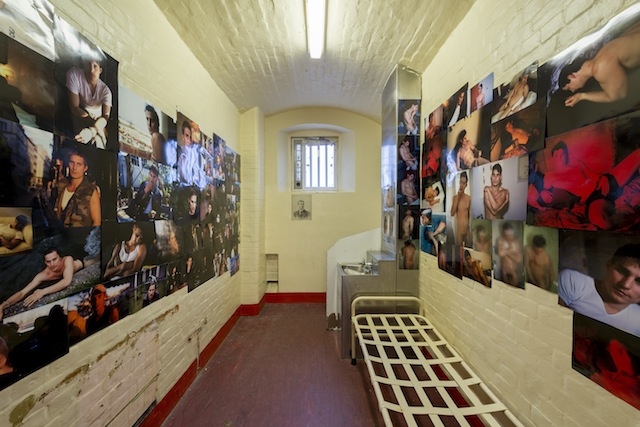HM Prison Reading 4 September – 4 December 2016
This exhibition, an Artangel project, marks no anniversary: the now decommissioned Reading prison was originally built in 1786 as a correctional house; it became a county gaol in 1793; the current cruciform structure was built in 1844; and Oscar Wilde, whose extended letter De Profundis inspired this exhibition, was incarcerated there between 1895 and 1897. Three years after his release, Wilde died of cerebral meningitis in Paris; De Profundis (which he had entrusted to his friend and ex-lover the journalist Robert Ross) was partially published in 1905. For the first seven Sundays of this exhibition, the letter was read out, in roughly six-hour sessions, by a series of actors, artists and writers in the former chapel-turned-rec room.
Other artists are showing works in the cells: Peter Dreher’s glasses of water, a subject he has been repeatedly painting since 1974 (to the point at which there are now more than 5,000 such works), are shown as one, two, then six in separate cells. At once a reflection of the artist’s own solitary studio confinement and at the same time evocative of the monotony of interned life, the still lifes that hang on dull pockmarked walls appear to mark the passing of time – like the daily ritual of tallying notches while doing time.
The atmosphere is suffocating. Some works are subdued. Steel bars obstruct small windows and, from the upper level cells, the sky is reduced to abstracted blue-grey squares. Doris Salcedo’s Plegaria Muda (2008–10), in its entirety comprising 162 units of two tables stacked surface to surface, a layer of compacted earth in between and symbolic of coffins, was originally made in response to gang violence in Los Angeles and mass graves that she saw in Colombia. Though a small number are included in this exhibition, the ‘coffins’, among which the visitor weaves, serve in this context as an acknowledgment of the unmarked graves of inmates buried in a plot of prison land ‘out back’.
But there are also works that are resistant to the context of prison, that rebel against the system that imprisoned Wilde, and seek connection to the world beyond the barbwired wall: Nan Goldin’s assembly of footage (including Jean Genet’s only film, Un chant d’amour, 1950, and an early recording of Wilde’s play Salome, 1891) and photography (The Boy, 2016, images of Goldin’s muse of more than 20 years tacked to the walls) imbue the cramped cells with a corporeal presence, forcing life into them with writhing bodies and brazen sexuality; In Memoriam (2016), a sculpture by Jean-Michel Pancin, occupies the former chapel with a concrete slab the dimensions of Wilde’s prison cell and the very door that shuttered him in isolation; Robert Gober presents two torsos through which a riverbed and bubbling cascade flow, bringing to mind the wateriness of memories and dreams as well as a craving for something natural in a place that is all metal, brick and sterile lino floors; and there are Wolfgang Tillmans’s self-portraits photographed using a distorted mirror found in one of the cells, portraits that hang in solitary while his film Imprisoned (2016) – offering scrambled glimpses of the town outside from behind window grills – plays out on an end wall of the cruciform building.
For a year during his internment, Oscar Wilde was not allowed to write. In 1896, a progressive warden, new to Reading Gaol, allowed Wilde to compose what would later become De Profundis. Ten letters, written by contemporary authors and artists, can be listened to in the C Wing: on metal tables lie headphones and paper copies of one-way correspondence. In these cells the visitor is invited to sit and listen to accounts of state- enforced separation. Some are fictional and others personal, but all encapsulate a sense of constraint, the desire for human bonds, the rawness of abrupt departures and the desire to write oneself outside.
This article first appeared in the December 2016 issue of ArtReview
